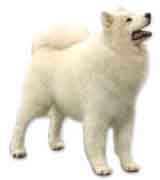Big DogsInformation About The Samoyed Dog Breed |
|
|
History and origin : An ancient Siberian breed, the Samoyed is a beautiful Spitz-type that takes his name from the Siberian tribe of the Samoyedes. He was used by the nomadic peoples of the same name as the breed to guard herds of reindeer and as a sled dog. This hardy breed has remained relatively pure for centuries. Description : The Samoyed stands 19 to 23.5 inches at the shoulder and weighs between 45 and 65 pounds. He has a strong medium-size body that is graceful and athletic and a face that always seems to be smiling. The undercoat is thick, soft, and insulating; the harder, straight outer coat grows through the undercoat. Shedding is year-round, particularly in early summer. Regular brushing and combing is required. If this breed is left outside, his coat may become matted and odorous. The color is white or off-white. About the breed : This is a very hardy dog who is intelligent, alert, and highly independent that, although obedient and friendly, can be a challenge to train. He has a sassy, impetuous side to his personality that is endearing yet troublesome. He is by nature a dominant, controlling breed that may become pushy and if not given proper leadership. Training can be difficult due to his independent, stubborn nature and therefore must begin early and must be firm and consistent. The Samoyed will resist surrendering control and is capable of showing aggression toward his owners, particularly if they have been too lenient. Establishing dominance is the key to owning a Samoyed. Any spoiling will increase the chances of dominance aggression. He is capable of taking over as the leader of the pack, using bites, barking, and tantrums to get his way. The most difficult command to teach this breed is the "Come." In addition, handling must occur every day so as to facilitate conflict-free grooming. If you wait too long, this breed will learn to be intolerant of brushing and may bite in protest. The Samoyed can be a good watchdog and barks more than most breeds, often to the point of irritation. He will bark, dig, and become a matted mess if left in the yard all day. This breed needs daily exercise or he may become restless, destructive, and loud. He is susceptible to hip dysplasia and does not do well in warm climates. Feeding : Recommended feeding for the Samoyed is 1 ½ - 2 ½ cans (13.3oz) of high-quality meat product with added biscuit is same amount or 5 cupfuls of a complete dry food. Ideal home: This breed loves the snow and is happiest in wide, open spaces. A house with a fenced yard is important, though this breed should not be left in a yard all day. The owner of a Samoyed must be an active, strong, dominant leader and must enjoy a breed that is intelligent and a challenge. Time to train, socialize, and groom the dog must be available daily. Passive owners will have control problems with this breed, resulting in a dominant, pushy dog capable of biting friends or family. This breed is not recommended for those with small children. Older children must not be allowed to roughhouse or to play chase games with this dog, and they should be capable of working with the dog in obedience. The elderly and the disabled may have trouble establishing dominance over this breed and should consider one only if they are physically capable of training, exercising, and grooming it every day. Back to the Big Dog Breed article page
| |
|
Related News About Dogs ' ); // get rid of newsfeed display by carp CarpConf('poweredby',''); CarpCacheShow('http://classifieds.agriscape.com/syndicate/dogs.rss'); ?>
|
|
|
|
|
|
Copyright © 2006-2007 dogguidance.com |


